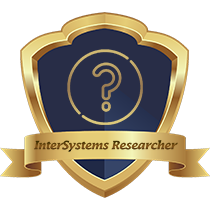User bio
404 bio not found
Member since Sep 12, 2023
Posts:
Replies:
Is this the kind of behavior you want?
Set pyType = ##class(%IPM.Utils.PydanticModelAdaptor).ExamplePydanticModel() // a convenience method to return a pydantic type object, with 3 fields defined: id, name, and email Set object = ##class(%IPM.Utils.PydanticModelAdaptor).%New(pyType) Set object.id = "1234", object.name = "John Doe", object.email = "john.doe@intersystems.com" Zwrite object.id, object.name, object.email // output // 1234 // "John Doe" // "john.doe@intersystems.com"
The above is achievable using the following. You can also implement %JSONExport, %Validate, etc.
Class %IPM.Utils.PydanticModelAdaptor Extends %RegisteredObject
{
/// Probably worthwhile to change the `PyModel` to something less likely to conflict with Pydantic field names
/// E.g. PyModel can be the type (aka class) object defined as
/// class UserModel(BaseModel):
/// id: int
/// name: str = Field(..., min_length=3)
/// email: Optional[str] = None
Property PyModel As %SYS.Python;
/// E.g.
/// PyFieldArray("id") = 1234
/// PyFieldArray("name") = "John Doe"
/// PyFieldEmail("email") = "john.doe@example.com" or unset
Property PyFieldArray As %String [ MultiDimensional ];
Method %OnNew(pyType As %SYS.Python) As %Status [ Private, ServerOnly = 1 ]
{
Set ..PyModel = pyType
Quit $$$OK
}
Method %DispatchGetProperty(Property As %String) [ ServerOnly = 1 ]
{
Set userFields = ..PyModel."model_fields"
Set fieldInfo = userFields.get(Property)
If '$IsObject(fieldInfo) {
$$$ThrowStatus($$$ERROR($$$GeneralError, "Unknown field name: "_Property))
}
Set fieldType = fieldInfo.annotation
If $Data(..PyFieldArray(Property), output) # 2 {
// TODO check the `fieldType`, raise error if not matching or violates min_length, max_length, etc.
Return output
}
$$$ThrowStatus($$$ERROR($$$GeneralError, "Field not set: "_Property))
}
Method %DispatchSetProperty(Property As %String, Val) [ ServerOnly = 1 ]
{
Set userFields = ..PyModel."model_fields"
Set fieldInfo = userFields.get(Property)
If '$IsObject(fieldInfo) {
$$$ThrowStatus($$$ERROR($$$GeneralError, "Unknown field name: "_Property))
}
Set fieldType = fieldInfo.annotation
// TODO check the `fieldType`, raise error if not matching or violates min_length, max_length, etc.
Set ..PyFieldArray(Property) = Val
}
ClassMethod ExamplePydanticModel() [ Language = python ]
{
from pydantic import BaseModel, Field
from typing import Optional
class UserModel(BaseModel):
id: int
name: str = Field(..., min_length=3)
email: Optional[str] = None
return UserModel
}
}
Set q = "select Name from %IPM_Storage.ModuleItem where Root = ?"
Set rs = ##class(%SQL.Statement).%ExecDirect(, q, folder)
If rs.%Next() { Write rs.%Get("Name") }
I'd recommend looking up the module info using SQL prior to deleting it.
Certifications & Credly badges:
Shuheng has no Certifications & Credly badges yet.
Global Masters badges:




Followers:
Following:
Shuheng has not followed anybody yet.

I was thinking about something like that too but wasn't sure how to dynamically construct an objectscript class.